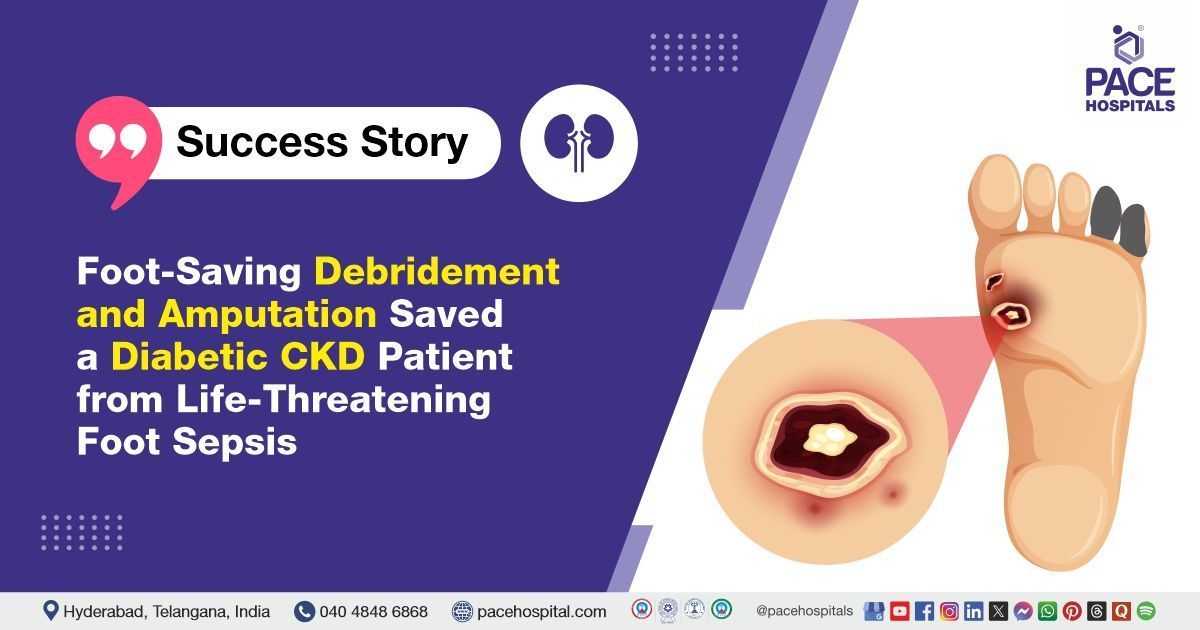Foot-Saving Amputation Saves Diabetic CKD Patient from Life-Threatening Sepsis
The Nephrology team at PACE Hospitals performed debridement and amputation of the 4th and 5th toes on a 59-year-old female patient who presented with symptoms of a diabetic foot infection, urinary tract infection (UTI), and acute kidney injury (AKI), all of which complicated her condition. The procedure aimed to relieve the infection, prevent further systemic complications such as sepsis, and manage the underlying factors contributing to her deteriorating health.
Chief Complaints
A 59-year-old male patient with a
body mass index (BMI) of 26.8 presented with chief complaints of left foot pain and progressive weakness over the past three weeks. This clinical presentation raised concerns and prompted further investigation to identify the underlying causes of his symptoms, aiming to determine an appropriate course of treatment.
History of Present illness
The patient initially experienced swelling and redness in her left foot for four days, accompanied by fever, and was admitted to an outside hospital, where she was treated with antibiotics. During her stay, her baseline creatinine increased to over 3 mg/dL, which led to the amputation of her left third toe. She was discharged on oral antibiotics, but a week later, she was readmitted to another hospital with a creatinine level of 4.3 mg/dL. The patient then presented to PACE Hospital with pain and weakness in her left foot, but without any history of fever, burning micturition, loin pain, or abdominal complaints in the past week. She was admitted for further evaluation and management.
Past History
The patient was a known case of
Type 2 Diabetes Mellitus for the past 20 years and
Hypertension for several years. She had undergone coronary angiography, which had revealed moderate
coronary artery disease (CAD) and was being managed medically. Her baseline serum creatinine had remained stable around 1.7 mg/dL, with the most recent recorded value also noted at 1.7 mg/dL, indicating previously stable renal function.
General Examination
Upon admission to PACE Hospitals for further evaluation of her ongoing symptoms and deteriorating renal function, the patient’s vital signs were found to be stable. Clinical examination revealed pallor, while cardiovascular assessment was unremarkable with normal heart sounds (S1 and S2). Respiratory system examination revealed normal vesicular breath sounds. Abdominal examination showed a soft, non-tender abdomen with no evidence of organomegaly, aligning with her lack of abdominal complaints.
Diagnosis
Upon admission to PACE Hospitals, the Nephrology team thoroughly reviewed the patient’s medical history and conducted a detailed clinical examination, considering her ongoing left foot symptoms and worsening renal function.
She was diagnosed with Type 2 Diabetes Mellitus (T2DM), Hypertension (HTN), and chronic kidney disease (CKD), presenting with Acute Kidney Injury (AKI).
Clinical evaluation further revealed a diabetic foot infection, which necessitated left foot debridement and amputation of the 4th and 5th toes. Additionally, a urinary tract infection (UTI) was identified, complicated by sepsis.
Given the severity of her condition and the need for specialized care, the patient was advised to undergo Diabetic Foot Treatment in Hyderabad, India, under the expert supervision of the Nephrology Department to manage her underlying complications effectively and support her recovery.
Medical Decision Making (MDM)
After consulting with the consultant nephrologist, Dr. A. Kishore Kumar, and in collaboration with other specialists, including Dr. K. B. Lakshmi, a comprehensive evaluation was conducted to determine the most suitable treatment approach for the patient.
Based on their collective clinical expertise, the team concluded that debridement of the left foot followed by amputation of the fourth and fifth toes would be the most appropriate course of action to effectively manage the diabetic foot infection, limit the spread of sepsis, and prevent further complications, considering the patient’s underlying diabetes, impaired renal function, and recent clinical deterioration.
Surgical Procedure
Following the decision, the patient was scheduled for a Debridement & Amputation Procedure in Hyderabad at PACE Hospitals, under the expert supervision of the Nephrology Department.
Before proceeding with surgery, several investigations were conducted. Urine tests revealed the presence of pus cells, and a renal ultrasound showed normal kidney function. As planned, the patient was admitted and treated with empirical intravenous antibiotics, which were later modified to a combination of beta-lactam/beta-lactamase inhibitors and lincomycin antibiotics. A plastic surgery consultation was obtained, and the patient underwent surgical debridement of the left foot to remove necrotic and infected tissue, aimed at controlling the spread of infection and promoting wound healing.
Due to the severity of the diabetic foot infection and non-viable tissue, amputation of the left fourth and fifth toes was performed. This intervention was necessary to prevent further complications, including systemic infection and worsening of the patient’s overall condition. Tissue culture, wound swab, and blood cultures remained sterile after 48 hours, while the urine culture identified Escherichia coli, which was sensitive to a class of beta-lactam antibiotics and a class of antibacterial agents.
During hospitalization, the patient’s serum creatinine levels remained between 3 and 4 mg/dL, indicating continued renal dysfunction.
Postoperative Care
After surgery, the patient’s condition was closely monitored due to the complexity of her case, which included a diabetic foot infection, recent amputation, and ongoing renal dysfunction. To support her recovery and prevent complications, vacuum-assisted wound dressing was done to promote healing of the surgical site. The doctors observed her elevated procalcitonin levels, which indicated the presence of infection, leading to the diagnosis of a urinary tract infection (UTI) and sepsis. Given these findings, the patient was promptly treated with appropriate antimicrobial therapy.
The team also noticed her low haemoglobin levels and dark-coloured stools, which raised concerns about possible gastrointestinal bleeding. Although the stool occult blood test was negative, the doctors decided to perform an upper gastrointestinal endoscopy (UGIE), which revealed fundal and antral gastritis with oedematous gastric mucosa. This condition was likely caused by the stress of her underlying illness and recent surgery.
To address the patient’s anaemia, intravenous iron supplementation was administered, correcting her low iron levels and preventing further complications. Additionally, her blood glucose levels were closely managed using intravenous insulin, taking into account her diabetes. This was critical to avoid any fluctuations in blood glucose that could hinder wound healing and recovery.
These interventions were essential to manage the patient's multifaceted health issues, stabilize her condition, and optimize her recovery, ensuring that each aspect of her care was addressed comprehensively during the post-operative phase.
Condition at Discharge
On examination, the patient’s pulse rate was 82 beats per minute, and her blood pressure was recorded at 150/80 mmHg. Cardiovascular examination revealed normal heart sounds (S1 and S2), indicating no immediate concerns regarding cardiac function. The respiratory system was assessed, and normal vesicular breath sounds were heard, suggesting no signs of respiratory distress or lung involvement.
Abdominal examination revealed a soft, non-tender abdomen with no evidence of organomegaly or discomfort. These assessments were performed to evaluate the patient’s overall physiological status and to rule out any additional complications, such as cardiovascular, respiratory, or abdominal issues, that might affect her recovery from surgery and ongoing treatment.
The doctors conducted these thorough examinations to ensure that her vital organs were functioning properly and to monitor for any signs of systemic complications related to her diabetes, infection, or the recent surgical procedures. These assessments were crucial in determining whether the patient’s condition had stabilized enough for discharge, ensuring that there were no underlying issues that could hinder her recovery or require further intervention before she left the hospital.
Discharge Notes
The patient was discharged in stable condition with instructions to follow up with fresh renal function tests (RFT) and to continue daily wound dressings at home to ensure proper recovery.
Discharge Medications
Upon discharge, the patient was prescribed a combination of medications to manage her multiple health concerns and support her recovery, including:
Antibiotics were prescribed to prevent any further infections, particularly given her recent diabetic foot infection and ongoing risk for sepsis.
Proton pump inhibitors (PPIs) were included to protect her gastrointestinal lining and prevent stress-related ulcers, especially considering her recent gastritis.
Sulfonylurea was prescribed to help control her blood sugar levels in conjunction with her diabetes management.
Anti-hypertensives, including beta-blockers and diuretics, were given to control her blood pressure and reduce the strain on her kidneys, as she had a history of hypertension and renal dysfunction.
Analgesics were prescribed for pain relief following her surgery, while an antacid was added to help neutralize stomach acid and alleviate any discomfort.
Aminoglycoside antibiotics were included to target any potential infections, particularly in the context of her urinary tract infection. These medications were carefully selected to address her specific needs, optimize her recovery, and manage her underlying health conditions.
Advice on Discharge
The patient was advised limb elevation and physiotherapy for both lower limbs to aid mobility and circulation. Regular dressing of the left leg wound was recommended to promote healing. Additionally, a daily water intake of 1.5 to 2 liters was advised to support renal function and overall recovery. Additionally, the patient was instructed to follow a salt-restricted diet to help control blood pressure and reduce fluid retention, both of which are important for managing kidney health and preventing further cardiovascular strain during the recovery period.
Emergency Care
The patient was informed to contact the Emergency ward at PACE Hospitals in case of any emergency or development of symptoms like fever, abdominal pain, or vomiting.
Review and Follow-up Notes
The patient was advised to consult the Nephrologist in Hyderabad at PACE Hospitals for a follow-up appointment after five days, along with fresh reports of complete blood picture, urea, creatinine, and electrolytes.
This follow-up was recommended to closely monitor her renal function, assess for any signs of infection or anaemia, and evaluate her overall recovery progress after surgery. Regular monitoring of these parameters was essential to ensure that her kidney function was stabilizing, the infection remained controlled, and no new complications had developed, thereby allowing the medical team to make timely adjustments to her treatment plan if necessary.
Conclusion
This case highlights the importance of coordinated specialist care in managing complex diabetic foot infections complicated by chronic kidney disease and sepsis, demonstrating how timely surgical intervention, personalized medical treatment, and focused post-operative support can lead to successful outcomes and improved patient recovery.
Timely Intervention: A Critical Factor in Preventing Severe Complications of Diabetic Foot Infections
Timely intervention plays a critical role in managing diabetic foot infections, particularly in patients with underlying conditions such as chronic kidney disease and sepsis. Early diagnosis and prompt treatment, including appropriate antimicrobial therapy and surgical procedures like debridement or amputation, when necessary, are essential to prevent the progression of infection and avoid severe complications. In patients with chronic kidney disease, collaboration with a nephrologist/nephrology doctor is crucial to ensure optimal management of renal function during treatment, especially when nephrotoxic antibiotics are used.
Delays in addressing diabetic foot infections can lead to increased risks of systemic infections, prolonged hospital stays, and higher rates of lower extremity amputations. Moreover, in cases where sepsis is present, early recognition and immediate management are vital to improve patient outcomes and reduce mortality rates. Implementing a comprehensive treatment plan that includes timely medical and surgical interventions, along with supportive care, can significantly enhance recovery and preserve limb function in affected individuals.
Share on
Request an appointment
Fill in the appointment form or call us instantly to book a confirmed appointment with our super specialist at 04048486868











